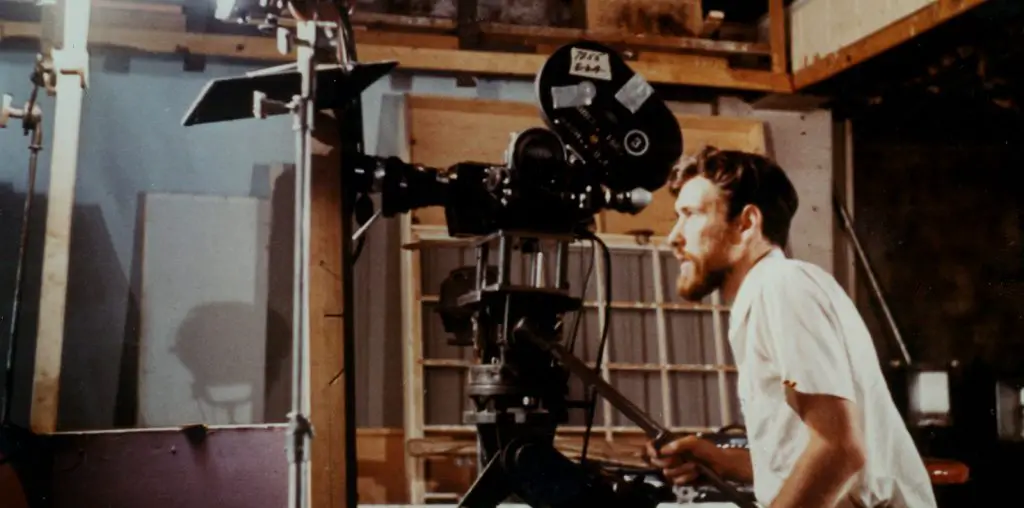
BOOTLEG FILES 337: “The Cube” (1969 made-for-television film by Jim Henson).
LAST SEEN: Available on various online video sites.
AMERICAN HOME VIDEO: It is available on iTunes from The Jim Henson Company.
REASON FOR BOOTLEG STATUS: Never made available on VHS, laserdisc or DVD.
CHANCES OF SEEING A COMMERCIAL DVD RELEASE: Give it time and it will turn up.
For Jim Henson, 1969 represented a Dickensian best of times and worst of times. The best of times, of course, was the debut of “Sesame Street,” which gave his Muppet characters an extraordinary home after years of wandering about the variety show circuit. Forty-one years later, Kermit and friends are still educating toddlers with their goofy charms.
But the worst of times – at least in terms of artistic expression – was a bizarre made-for-television film called “The Cube.” Barely acknowledged when it was first broadcast, the film has come down through the years as a puerile mess that Henson’s considerable talents did not extend into the realm of avant-garde cinema.
“The Cube” was part of an NBC anthology series called “Experiment in Television.” The network wanted to be seen as being in touch with the cultural shifts taking place in the performing arts, and this series was used to offer a small screen venue for risk-taking productions similar to edgier off-Broadway theater and underground movies. However, the network wasn’t willing to surrender its prime evening programming slot for non-commercial work. Instead, “Experiment in Television” was broadcast in the dismal low-ratings world of Sunday afternoon – and only when there wasn’t a major sports game that required air time.
Jim Henson had already created a non-Muppet film that was presented on this series – the 1968 documentary “Youth ‘68″ – and the network gave him the green light to create an off-beat dramatic work. The result was “The Cube,” which seemed to take uneven chunks of inspiration from the likes of Franz Kafka, Jean-Paul Sartre, Rod Serling, and the Abbott and Costello skit “Crazy House.” If that sounds unappetizing, you can’t believe what it actually looks like.
The title of this 52-minute film is a white-paneled room that is the prison of an unidentified man. The man has no clue how he arrived in space or why he is being kept there. Throughout the film, a parade of people come into the room through secret doors and engage him in weird conversations. All of the people are able to exit the room, but the man is unable to follow them out.
The first visitor is Arnie the handyman – he delivers a stool that is stained with strawberry jam. Arnie returns later to deliver a telephone – but every time the man tries to make a call, he gets connected to Arnie. Arnie comes back several times to clean up various damage to the room, and he always complains about his job.
Another frequent visitor is a British-accented gent who identifies himself as the manager of the establishment where the man in the cube is being held. He tries to deflect inquiries regarding the man’s situation, although it becomes clear that there are other cubes in the same building.
For most of “The Cube,” the man is subjected to a number of stereotypical caricatures: a pretentious interior designer who toys with repainting the room yellow or tangerine before agreeing that the white color scheme is best; a black militant who complains that the man’s room is all white; doctors who examine the man as if he was a race horse; two German-accented storm troopers who handcuff the man after discovering weapons hidden in the floor; and a rock band who perform the tune “You’ll Never Get Out.”
A pair of gorillas in tutus also show up, along with a boy on a tricycle who chants “You’re never gonna get out of here.” Perhaps the most surprising visitors to “The Cube” are a studio light stand and the unpainted edge of the set – they make an unscripted appearance when the camera overshoots a tracking shot.
Throughout “The Cube,” there is endless talk about reality, sanity, self-identity and death. One visitor informs the man that he is actually part of a TV play, and he produces a small television that shows the production’s closing credits. An elderly creep peeks in and asks the man, “Has it ever occurred to you that you’re dead and this is what death is?” There is also a cocktail party in the cubed room where the man realizes that everyone present is just a projected image.
It is clear that Henson (along with co-writer Jerry Juhl) was trying to say something with this production. Yet the film ultimately says nothing, due in large part to the shallow philosophical insights (hey, we all know that life stinks) and the painfully amateurish acting from the ensemble cast. Truly, some of the performances in “The Room” are among the worst ever put on videotape.
It also does not help that the trapped man (played by Richard Schaal) never seems truly perturbed by his situation until the tail end of the film. If the man at the center of the drama comes across as annoyed and baffled about his fate, how else can the audience react except to share his annoyance and bafflement?
“The Cube” had its premiere on February 23, 1969, but it made no great impact. NBC ran a repeat of the production two years later, and then it dropped out of sight. Across the Internet, there are several people who claim that they saw “The Cube” in high school during the early 1980s. For the most part, it was completely forgotten – even Henson’s biographers skim over it when considering his pre-“Sesame Street” career.
“The Cube” has turned up on a number of Internet video sites – there are both color and black-and-white versions, as well as a version with a dual English and Polish soundtrack. The film was never released in any home entertainment format, although The Jim Henson Company has made it available on iTunes.
In retrospect, we should all be glad that “Sesame Street” gave Henson the opportunity that he truly deserved and that he abandoned any thought of avant-garde filmmaking. If there is a place for “The Cube,” it would be in the bottom of Oscar the Grouch’s garbage can!
IMPORTANT NOTICE: The unauthorized duplication and distribution of copyright-protected material, either for crass commercial purposes or profit-free s***s and giggles, is not something that the entertainment industry appreciates. On occasion, law enforcement personnel boost their arrest quotas by collaring cheery cinephiles engaged in such activities. So if you are going to copy and distribute bootleg videos and DVDs, a word to the wise: don’t get caught. Oddly, the purchase and ownership of bootleg videos is perfectly legal. Go figure!


I thought it was very interesting and was glad to find it again on the Internet.
No, the “Crazy House” sketch was a burlesque chestnut popularized by Abbott and Costello. The sketch involved Costello as a patient in a mental hospital, where his room is constantly invaded by a parade of exaggerated lunatics. There was an Olsen & Johnson film called “Crazy House,” but that has nothing to do with that famous sketch.
Wasn’t CRAZY HOUSE Olsen and Johnson?
Incidentally, here’s some of Jim’s other quirky shorts…
Cat and Mouse:
http://www.youtube.com/watch?v=pTjsl_qnIsQ
Idea Man:
http://www.youtube.com/watch?v=SBPZoB8z9As
Time Piece (1965):
http://www.youtube.com/watch?v=Eh4mRrwkxPQ
Ripples (1967):
http://www.youtube.com/watch?v=cKzzw3SEJb4
Paperwork Explosion (1967):
http://www.youtube.com/watch?v=_IZw2CoYztk
Wheels That Go (1967):
http://www.youtube.com/watch?v=OPJSYs199jc
Youth ’68 (excerpt):
http://www.youtube.com/watch?v=sXYNFyc0WY0
Baker #1 (from Sesame Street, 1969)
http://www.youtube.com/watch?v=QXnxTbCECjw
Baker #5 (from Sesame Street, 1969):
http://www.youtube.com/watch?v=3fzCnTg3kkA
Baker #10 (from Sesame Street, 1969):
http://www.youtube.com/watch?v=ts1WvLWbwEw
The King of Eight (from Sesame Street, 1970):
http://www.youtube.com/watch?v=9GOqM18Bhhg
The Queen of Six (from Sesame Street, 1970):
http://www.youtube.com/watch?v=qHDgppc3Sig
Limbo, The Organized Mind (1974):
http://www.youtube.com/watch?v=GN23Q4wgJ6w
I suppose “The Cube” can be seen as a culmination of that part of Jim that was far from the Muppets he helped to create and endure far longer than these projects.
Aside from it being unheard of, it did end up inspiring some horror guy into making a few movies using the name “Cube”, though I don’t think they have nothing to do with Jim Henson’s original film. Although there is this German live stage play version called “Kubus”…
http://video.google.com/videoplay?docid=-2130748754301931035
I do think the film (and how it was seen in schools) was probably meant to evoke discussions one may have about the way he or she treats him/herself or others, or how others may treat him/her. I see that theme working quite well in this little special, but perhaps it’s lost on the populous who seem to have other opinions to share of it’s quirky nature. Most seem to call it a horror when I consider it a fine example of dark comedy.